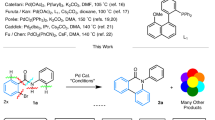Abstract
A comprehensive DTA study is reported of eight methyl-phenols, 4-methoxy-phenol and four methyl-halo-phenols and of the correspondingp-nitrobenzoylchloride, 3,5-dinitrobenzoylchloride andp-phenylazobenzoylchloride derivatives, prepared ’in situ’ by heating intimate mixtures of phenol and acid chloride in a DTA system. The thermal analysis data, in particular, the derivative formation temperatures, are interpreted in terms of the inductive, mesomeric and steric effects associated with the ring substituents of the phenol and acid chloride and the extent of inter- and intramolecular hydrogen-bonding existing in these systems. The DTA data collectively, provide a comprehensive data base for the identification and characterisation of these phenols via DTA.
Zusammenfassung
An durch Erhitzen inniger Mischungen aus Phenol und Säurechloriden in einem DTA-System hergestellten acht Methylphenolen, an 4-Methoxyphenol, an vier Methylhalophenolen und an den entsprechendenp-Nitrobenzoylchlorid-, 3,5-Dinitrobenzoylchlorid- undp-Phenylazobenzoylchloridderivaten wurden ausführliche DTA-Untersuchungen durchgeführt. Thermoanalytische Ergebnisse, insbesondere die Bildungstemperatur der Derivate wurden als Ausdruck des induktiven, mesomeren und sterischen Effektes bezüglich der Substituenten am Phenolring und des Säurechlorides sowie des Ausmaßes der in diesem System existierenden inter- und intramolekularen Wasserstoffbrückenbindungen gewertet. Die Gesamtheit der DTA-Daten ist gleichzeitig eine ausführliche Datenreferenz zur Identifizierung und Charakterisierung dieser Phenole mittels DTA.
Similar content being viewed by others
References
E. W. Crandall and M. Pennington, J. Chem. Educ., 57 (1980) 824.
N. G. Buckman, J. O. Hill and R. J. Magee, J. Therm. Anal., 36 (1990) 289.
T. Schaefer, S. R. Salman and R. Sabastian, Canad. J. Chem., 62 (1984) 113.
S. R. Salman and K. F. Abas, Thermochim. Acta, 149 (1989) 381.
S. Patai, Ed., The Chemistry of the Hydroxyl Group', Part 1, Wiley-Interscience, N. Y., 1971 Ch.7.
E. O. Woolfolk and J. M. Taylor, J. Org. Chem., 22 (1957) 827.
N. D. Cheronis, J. B. Entrikin and E. M. Hodnett, ’Semimicro Qualitative Organic Analysis’, 3rd Edn., Wiley-Interscience, N. Y. 1965.
A. I. Vogel, ’Textbook of Practical Organic Chemistry’. 4th Edn., Longman, N. Y. 1981.
M. Phillips and G. L. Keenan, J. Amer. Chem. Soc., 53 (1931) 1924.
E. P. Serjeant and B. Dempsey, IUPAC Chemical Data Series No 23: ’Ionisation Constants of Organic Acids in Aqueous Solutions’, Pergamon Press, N. Y. 1979.
P. J. Pearce and R. J. J. Simkins, Canad. J. Chem., 46 (1968) 241.
G. Körtum, W. Vogel and K. Andrussow, Pure and Appl. Chem., 1 (1960) 187.
Author information
Authors and Affiliations
Rights and permissions
About this article
Cite this article
Buckman, N.G., Hill, J.O. & Magee, R.J. A DTA study of phenols. Journal of Thermal Analysis 36, 2555–2566 (1990). https://doi.org/10.1007/BF01913653
Received:
Issue Date:
DOI: https://doi.org/10.1007/BF01913653




